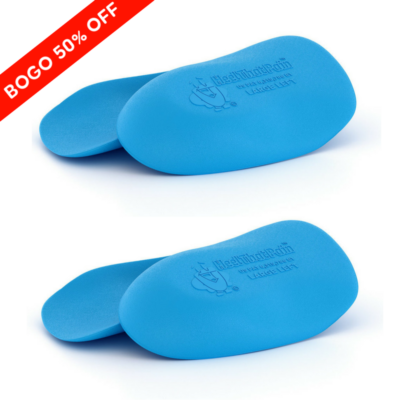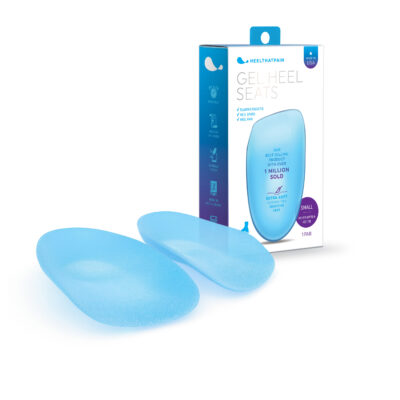Causes of Heel Pain
Remember, if your heel pain has become severe, Internet research should not take the place of seeking professional medical assistance, but reviewing these common causes of heel pain can help you in identifying symptoms that match your own.
Plantar Fasciitis |
|
| Symptoms | Podiatrists cite Plantar Fasciitis as being the most common cause of heel pain. Typical symptoms of this condition include sensations of pain, burning or heat in one or both heels. Plantar Fasciitis is closely associated with heel pain that occurs upon taking your first steps in the morning, or when getting up after a prolonged period of being seated. |
| Causes | Plantar Fasciitis occurs when the plantar fascia ligament spanning the arch of the foot from heel to ball suffers from over-flexion or stretching. The ligament becomes irritated and inflamed and small tears may develop in the tissue. The plantar fascia ligament is designed to bounce with the spring of your step, but in the case of Plantar Fasciitis, this elastic support is reduced, resulting in heel pain as the foot bears the weight of each step. Risk factors for this ailment include intensive exercise without adequate periods of rest, having an irregular gait, being overweight, wearing improper footwear and the normal aging process. |
| Treatment Options |
Most cases of Plantar Fasciitis can be resolved without drugs or surgery. A combination of rest, icing, heel stretching exercises and daily use of a specialized Plantar Fasciitis orthotic shoe insert, such as Heel Seats, proves effective in the majority of cases. Nine out of ten Heel That Pain customers report significant heel pain reduction or complete healing from utilizing our clinically-tested inserts. |
| Further Reading |
Detailed Plantar Fasciitis Overview |
Shop our guaranteed heel pain products!
Achilles Tendonitis |
|
| Symptoms | Another common cause of heel and calf pain is Achilles Tendonitis. Symptoms are frequently described as an aching pain in the back of the lower leg and just above the heel. This sensation is typically worse after exercise and upon first waking up in the morning. If you ever experience severe and sudden pain in the calf, you should seek immediate medical attention as extreme pain may be the result of a torn Achilles tendon. |
| Causes | Achilles Tendonitis occurs when the band of tissue connecting your calf muscles to your heel bone, called the Achilles tendon, suffers repetitive or extreme strain. Injury to the tendon is most commonly seen in runners and other athletes. Age is also a factor, particularly when elders exercise only sporadically, such as on the weekends. |
| Treatment Options |
Achilles Tendonitis is typically treated via physical therapy and the use of an orthotic device that raises the heel to minimize strain on the tendon. Rest, icing and elevating the leg may be helpful home remedies for this condition, but if calf pain persists for a prolonged period, seek medical attention. In the case of a torn Achilles tendon, surgery may be warranted. |
| Further Reading |
Achilles Tendinitis Overview |
Heel Spurs |
|
| Symptoms | Sharp, prodding sensations in the bottom of the heel may be a sign of heel spurs. Heel spurs frequently develop in association with Plantar Fasciitis. Heel spurs form when calcium builds up on the heel bone, creating hooked, pointed or shelf-shaped profiles. Heel spurs are also called ‘calcaneal spurs’ or ‘osteophytes’. |
| Causes | It is believed that heel spurs form in conjunction with Plantar Fasciitis as the body’s way to attempt to ‘shore up’ the loose or misaligned plantar fascia ligament, spanning the arch of the foot. When the biomechanics of the plantar fascia ligament are imbalanced, these calcium protrusions are attempting to support the damaged tissue. Like Plantar Fasciitis, heel spurs can develop from walking with an irregular gait or participating in extreme amounts of exercise, standing, or walking without adequate rest or supportive footwear. |
| Treatment Options |
Though heel spurs, in and of themselves, do not sense pain, they cause pain by prodding into the fatty padding on the bottom of the heel each time you take a step. Pain can range from mild to severe. Rest is very important in recovering from this condition, as is the use of a specialized orthotic shoe insert designed to realign the plantar fascia ligament and enable heel spurs and the heel fat pad to heal. Heel Seats are endorsed by the American Podiatric Medical Association and are designed specifically for the treatment of heel spurs and Plantar Fasciitis. In extreme cases, physicians may recommend surgery, but this is the exception rather than the rule. |
| Further Reading |
|
Heel Trauma |
|
| Symptoms | A single traumatic incident such as an accident, a fall or injury to the heel with a foreign object can result in heel pain. If you experience a sudden onset of pain following a mishap, rather than heel pain developing without an obvious cause, you should seek medical attention. |
| Causes | Slipping, taking a wrong step on an uneven surface or stepping on a hard or sharp object can all cause injury to the heel bone or the fatty layer of tissue protecting the heel. |
| Treatment Options |
If pain is severe, call your doctor. If you have stepped on a sharp object and are shedding blood, go to the nearest emergency center. |
| Further Reading |
|
Bursitis of the Heels |
|
| Symptoms | Bursitis affects the bursae, or fluid-filled sacs that cushion and lubricate major joints of the body. Pain from bursitis of the heel is usually felt in the back of the heel where it meets the Achilles tendon. The skin may be red, tender, and warm to the touch. |
| Causes | Bursitis of the heel develops when the retrocalcaneal bursa becomes inflamed and irritated through rubbing and pressure from ill-fitting shoes, or repetitive trauma. |
| Treatment Options |
Treatment for mild bursitis is very similar to that of plantar fasciitis and heel spurs. Rest and ice are the first options to consider when you are experiencing pain. Shoe inserts can also help reduce and prevent pain from bursitis because they cushion the heel and reduce the impact from exercise. |
| Further Reading |
Could Your Heel Pain Be Bursitis? |
Osteomyelitis of the Heel |
|
| Symptoms | Osteomyelitis of the heel is a bone infection that not only causes localized pain in the joint, but may also have accompanying symptoms of infection like fever and lethargy. |
| Causes | Osteomyelitis is caused by microorganisms like bacteria and fungi, and can developed if an open wound on the foot becomes infected. It is more common in children because of accelerated bone growth, and can also be associated with diabetes because of foot ulcers. |
| Treatment Options |
If you suspect that you may have osteomyelitis because of pain that feels localized in the bone, especially following a foot injury or ulcer, it is important that you visit a physician or podiatrist as soon as possible. Medical treatments include antibiotics and surgery to remove infected tissues. |
| Further Reading |
Osteomyelitis Overview |
Haglund’s Deformity |
|
| Symptoms | Haglund’s deformity, also known as “pump bump,” presents as the enlargement of the back of the heel bone. Pain from Haglund’s deformity can be felt in the back of the heel near the Achilles tendon, and may also involve redness, swelling, and tenderness. |
| Causes | Haglund’s deformity is usually the result of ill-fitting or unsupportive shoes (like high heels, or pumps). It results when the Achilles tendon is caught between the heel bone and the back of the shoe, causing irritation and pain. |
| Treatment Options |
Pain from Haglund’s deformity can usually be controlled with anti-inflammatory medications, proper footwear, and icing the area. Orthotics can also help improve positioning of the foot and controlling movement within the shoe, which can also help reduce symptoms. |
| Further Reading |
Have a Lump in Your Heel? Here’s What You Should Know Haglund’s Deformity Facts |
Posterior Tibial Tendonitis |
|
| Symptoms |
Posterior tibial tendonitis is a common injury involves the irritation of or trauma to the posterior tibial tendon, which attaches the calf muscle to the bones of the inner foot. If you have posterior tibial tendonitis, you may feel pain in the inside of your foot, heel, ankle, and even up a few inches into your shin. Looking for a telltale sign that you might have posterior tibial tendonitis? Try standing on one foot and raising your heel off the floor. If you experience difficulty and pain, you probably have posterior tibial tendonitis. |
| Causes | The posterior tibial tendon can become injured, torn, or inflamed through high-impact sports or simply through overuse. You may first notice pain with movements that involve pushing off from the ground such as walking, running, and jumping. |
| Treatment Options |
Treatment for posterior tibial tendonitis includes rest, and supportive footwear or shoe inserts to support your arches. Calf and ankle stretches, and strengthening exercises for the posterior tibial tendon can also provide short and long-term relief. |
| Further Reading |
Posterior Tibial Tendon Dysfunction |
Overpronation |
|
| Symptoms | Pain from overpronation may include heel pain as the arch becomes strained, bunions or pain in the big toe as the skin rubs against the shoes, and tightness in the muscles of the leg as the body works to compensate for the improper gait. If you suspect you have overpronation, take a look at the tread on your shoes. Most people with overpronation will see unusual wear patterns on the tread, with heavier wear on the inside edge of the sole. |
| Causes | Overpronation happens when your foot rolls too far inward, which decreases the foot’s efficiency in absorbing shock and puts excess force on the inner toes. This problematic gait can place unusual wear and tear on the skin, bones, and tissues of the foot while you walk or run, leading to pain, irritation, and strain. Overpronation can eventually lead to plantar fasciitis, as well as a variety of other foot, heel, and leg conditions. |
| Treatment Options |
Common treatment options for overpronation are orthotic inserts and stretching. Heel and leg pain can often be eased by stretching the foot and calf muscles, and exercising the foot can add stability and prevent future pain. |
| Further Reading |
Plantar Fasciitis and Overpronation How to Correct Posture From the Feet Up |
Researching heel pain symptoms can help you narrow what might be causing your pain. But when in doubt, talk to your doctor about your unique situation for an accurate diagnosis and treatment plan.






